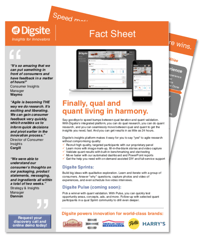
A concern with qualitative market research is that it lacks the statistical validity of quantitative research. However, using a method called “Triangulation,” you can find trends that, while not statistically valid, can reassure the leaders of your company that you’re on the right path.
In a recent webinar, “5 Ways to Build Your Customer Into the Front End of Innovation”, we discussed the various qualitative research methods and tools that you can use to find “golden nuggets,” the verbatim quotes from customers that can lead to new ideas.
Our good friend Darin Eich presented with me, and he mentioned the technique called “Triangulation” which you can use to validate your findings. I reached out to Darin to shed more light on the approach.
The Technique: Simple Approach Yields Superior Data Analysis
Remember the “golden nuggets?” With triangulation, you’re looking to find them in multiple research sources.
For example, you may use one-on-one interviews, online surveys, and perhaps run a Digsite Sprint - an online insights community - in your research. When you triangulate, you look for insights that are consistent across each data source.
For example, if you’re doing a UX research project to determine what links are most valuable on the homepage, you ask participants through a number of different methods. Patrick Kennedy, a User Experience Architect and Design Researcher, blogged about the different methods on the blog Johnny Holland. His UX research methods include the following:
- Analytics
- Stakeholder interviews
- Interviews (face-to-face or phone as need be)
- Cultural probe (aka diary study)
- Focus groups or workshops
- Secondary research (including an examination of market research data)
- Quantitative survey (to help validate findings with a much larger sample size)
- Usability testing (of existing product or early concepts)
If you can’t use all of these data sources, then at least look for multiple voices within one data source.
Darin noted that when he first started researching innovation, he was always looking for the one person who had a unique, original idea. But that means that your maverick thinker isn’t reflecting the common needs of the market.
“You want to see that the customer, the company, and the product designer are all agreeing on the same ideas,” he said. “It’s validated, wanted and needed. A triangulation indicates the idea’s time has come.”
Beating Bias: Why Triangulation is Important
If you choose to only go with one data source, Patrick Kennedy believes you’re playing with fire. “Each of these (data sources) can be incredibly useful for giving insight into a particular aspect of what you’re studying, but relying solely on one is a big mistake,” he blogs.
Kennedy notes that you become particularly susceptible to measurement, sampling and procedural bias - all detailed nicely in this post. I’ll sum them up as succinctly as possible here:
- Measurement Bias - Influenced by the setting used to collect data. For example, peer pressure in a focus group can create measurement bias.
- Sampling Bias - Applies to when you don’t cover the entire population of the group you are researching, or you omit a certain portion of it because it’s more convenient.
- Procedural Bias - When you’re applying pressure to a participant to provide information, and it affects their answer.
If you use triangulation, you avoid the biases, and have higher confidence that the research is accurate. That’s a big plus when you’re presenting the finding to your management team. Show a theme repeated by several independent groups, and you have the right idea at the right time.
What if Triangulation Doesn’t Occur?
If you’re in the early stages of product development or a UX project and triangulation isn’t occurring, it could be a clear indication that you’re heading in the wrong direction. Some solutions include:
- Add in another research source - perhaps the methods you used didn’t reach the specific target market.
- Recruit more people to one of the sources and ask the question again. Maybe your sample size wasn’t large enough to attain triangulation.
- Review Patrick Kennedy’s post. Check out his “Tips for Triangulation” toward the end of the post.
Whether triangulation proves you right or wrong, it’s an excellent method for validating online qualitative research data. Allow for the additional market research resources to make it happen.
Learn more about how Digsite can fit your market research needs-download the Fact Sheet!





